Burden of Total and Cause-Specific Mortality Related to Tobacco Smoking among Adults Aged ≥45 Years in Asia: A Pooled Analysis of 21 Cohorts
Background:
Tobacco smoking is a major risk factor for many diseases. We sought to quantify the burden of tobacco-smoking-related deaths in Asia, in parts of which men's smoking prevalence is among the world's highest.
Methods and Findings:
We performed pooled analyses of data from 1,049,929 participants in 21 cohorts in Asia to quantify the risks of total and cause-specific mortality associated with tobacco smoking using adjusted hazard ratios and their 95% confidence intervals. We then estimated smoking-related deaths among adults aged ≥45 y in 2004 in Bangladesh, India, mainland China, Japan, Republic of Korea, Singapore, and Taiwan—accounting for ∼71% of Asia's total population. An approximately 1.44-fold (95% CI = 1.37–1.51) and 1.48-fold (1.38–1.58) elevated risk of death from any cause was found in male and female ever-smokers, respectively. In 2004, active tobacco smoking accounted for approximately 15.8% (95% CI = 14.3%–17.2%) and 3.3% (2.6%–4.0%) of deaths, respectively, in men and women aged ≥45 y in the seven countries/regions combined, with a total number of estimated deaths of ∼1,575,500 (95% CI = 1,398,000–1,744,700). Among men, approximately 11.4%, 30.5%, and 19.8% of deaths due to cardiovascular diseases, cancer, and respiratory diseases, respectively, were attributable to tobacco smoking. Corresponding proportions for East Asian women were 3.7%, 4.6%, and 1.7%, respectively. The strongest association with tobacco smoking was found for lung cancer: a 3- to 4-fold elevated risk, accounting for 60.5% and 16.7% of lung cancer deaths, respectively, in Asian men and East Asian women aged ≥45 y.
Conclusions:
Tobacco smoking is associated with a substantially elevated risk of mortality, accounting for approximately 2 million deaths in adults aged ≥45 y throughout Asia in 2004. It is likely that smoking-related deaths in Asia will continue to rise over the next few decades if no effective smoking control programs are implemented.
Please see later in the article for the Editors' Summary
Published in the journal:
Burden of Total and Cause-Specific Mortality Related to Tobacco Smoking among Adults Aged ≥45 Years in Asia: A Pooled Analysis of 21 Cohorts. PLoS Med 11(4): e32767. doi:10.1371/journal.pmed.1001631
Category:
Research Article
doi:
https://doi.org/10.1371/journal.pmed.1001631
Summary
Background:
Tobacco smoking is a major risk factor for many diseases. We sought to quantify the burden of tobacco-smoking-related deaths in Asia, in parts of which men's smoking prevalence is among the world's highest.
Methods and Findings:
We performed pooled analyses of data from 1,049,929 participants in 21 cohorts in Asia to quantify the risks of total and cause-specific mortality associated with tobacco smoking using adjusted hazard ratios and their 95% confidence intervals. We then estimated smoking-related deaths among adults aged ≥45 y in 2004 in Bangladesh, India, mainland China, Japan, Republic of Korea, Singapore, and Taiwan—accounting for ∼71% of Asia's total population. An approximately 1.44-fold (95% CI = 1.37–1.51) and 1.48-fold (1.38–1.58) elevated risk of death from any cause was found in male and female ever-smokers, respectively. In 2004, active tobacco smoking accounted for approximately 15.8% (95% CI = 14.3%–17.2%) and 3.3% (2.6%–4.0%) of deaths, respectively, in men and women aged ≥45 y in the seven countries/regions combined, with a total number of estimated deaths of ∼1,575,500 (95% CI = 1,398,000–1,744,700). Among men, approximately 11.4%, 30.5%, and 19.8% of deaths due to cardiovascular diseases, cancer, and respiratory diseases, respectively, were attributable to tobacco smoking. Corresponding proportions for East Asian women were 3.7%, 4.6%, and 1.7%, respectively. The strongest association with tobacco smoking was found for lung cancer: a 3- to 4-fold elevated risk, accounting for 60.5% and 16.7% of lung cancer deaths, respectively, in Asian men and East Asian women aged ≥45 y.
Conclusions:
Tobacco smoking is associated with a substantially elevated risk of mortality, accounting for approximately 2 million deaths in adults aged ≥45 y throughout Asia in 2004. It is likely that smoking-related deaths in Asia will continue to rise over the next few decades if no effective smoking control programs are implemented.
Please see later in the article for the Editors' Summary
Introduction
Tobacco smoking is a major risk factor for many diseases, including cardiovascular disease (CVD), respiratory disease, and cancers of the lung and multiple other sites [1],[2]. In the US and many other Western countries, the epidemic of tobacco smoking started in men in the early 1900s and reached its peak in the 1960s; a similar epidemic occurred among women ∼40 y later [3]–[5]. The main increase in tobacco-related deaths in these countries was not seen until the second half of the 20th century [3],[6]–[8]. By the 1990s, tobacco smoking accounted for an estimated one-third of all deaths and >50% of cancer deaths in adult men [3],[6]–[8]. With increasing awareness of smoking-associated risks and heightened anti-smoking campaigns, tobacco use has steadily declined in the US and many other developed countries over the past 20–30 y [3]–[5],[9],[10], resulting in a recent decrease in lung cancer and other smoking-related diseases in these countries [3],[11].
In Asia, where ∼60% of the world population lives, tobacco control programs are less well developed, particularly in low- and middle-income countries including China and India, the two most populous countries in the world. Inadequate public awareness of smoking risks, combined with aggressive marketing by tobacco companies, has resulted in a sharp increase in tobacco smoking among men in many Asian countries over the past few decades [3],[11],[12]. Smoking prevalence in women was traditionally very low but has increased in recent decades in some Asian countries [3],[11],[12]. More than 50% of men in many Asian countries are smokers [12],[13], approximately twice the level in many Western countries. Despite a recent decline in smoking prevalence in several high-income Asian countries [11],[13], tobacco use in most Asian countries remains very high. Indeed, Asia is now considered the largest tobacco producer and consumer in the world. More than half of the world's 1.1 billion smokers live in Asia [3],[13]. Because many Asian countries are in the early stages of the tobacco epidemic, it is likely that the burden of diseases caused by tobacco smoking will continue to rise over the next few decades, and much longer if the tobacco epidemic remains unchecked.
The size of the effect of tobacco smoking on risk of death, typically measured using smoking-associated relative risks (RRs), varies across countries because of differences in characteristics of smokers, smoking behaviors, and tobacco products. Over the past 15 y, several studies have investigated associations between smoking and selected health outcomes in certain Asian populations and have estimated smoking-associated population attributable risk (PAR) [14]–[21]. Some studies estimated burden of disease due to smoking in a specific Asian country/region [14],[16],[17],[19],[20]. However, most of these estimates were derived from either a single cohort study or studies using a less-than-optimal research design. In this study, we first estimated RRs of overall and cause-specific mortality associated with tobacco smoking as well as smoking prevalence, using data from ∼1 million participants recruited in 21 prospective cohort studies in seven countries/regions that account for ∼71% of Asia's total population. We then used these estimates and mortality data from the World Health Organization [22] to quantify deaths attributable to tobacco smoking in these Asian populations.
Methods
This study was approved by the ethics committees for all the participating studies and of the Fred Hutchinson Cancer Research Center.
This study utilized resources from a recent pooling project of prospective cohort studies conducted as part of the Asia Cohort Consortium that quantified the association between body mass index and risk of overall and cause-specific mortality in Asians [23]. Cohorts included in the current analysis were in Bangladesh, India, mainland China, Japan, Republic of Korea, Singapore, and Taiwan. A brief description of each of the participating cohort studies is provided in Text S1. All of the cohort studies collected baseline data on demographics, lifestyle factors, body mass index, and history of tobacco smoking, which included current smoking status, duration, and amount and types of tobacco products. Data on all-cause and cause-specific mortality were ascertained through linkage to death certificate data or active follow-up. Additional data were collected on other baseline variables, including education, marital status, alcohol consumption, physical activity, and previous diagnosis of selected diseases, including diabetes, hypertension, cancer, and CVDs. Individual-level data from all participating cohorts were collected and harmonized for statistical analysis.
The association between tobacco smoking and risk of death was examined using Cox proportional hazards regression models, employing a categorical representation of tobacco smoking as the predictor variable. Lifetime nonsmokers were used as the reference for estimating hazard ratios (HRs)—as measures of RR of death for the exposed versus the non-exposed population—and 95% confidence intervals associated with ever, former, and current smoking, as well as pack-years smoked, after adjusting for potential confounders including baseline age, education, urban/rural residence, body mass index, and marital status. All analyses were conducted separately for men and women because of large differences in smoking prevalence. Analyses were country-specific unless otherwise noted. To improve the stability of point estimates in the analyses of pack-years of smoking and for risk of death due to site-specific cancer, as well as types of CVD and respiratory diseases, cohorts were combined into broad ethnic groupings: South Asians (Indians and Bangladeshis) and East Asians (Chinese [including cohorts from mainland China, Singapore, and Taiwan], Japanese, and Koreans), and categorized further among East Asians into Chinese/Koreans and Japanese. No smoking-associated HR was estimated for Bangladesh separately because of the small sample size. The number of Koreans in this study was small, and, thus, they were combined with Chinese individuals in some analyses. Bidi smoking is common in India and Bangladesh; thus, information regarding bidi smoking was incorporated to construct smoking variables, including pack-years smoked (4 bidis = 1 cigarette based on approximately 0.25 and 1.0 g of tobacco per bidi and cigarette, respectively).
In the models, the effect of tobacco smoking on mortality was assumed to be cohort-specific. For each cohort, we assumed that the log-HR for tobacco smoking has a fixed-effect component that is common to all cohorts within each country and a random effect that is cohort-specific. Random effects for log-HRs were assumed to be normally distributed, with mean zero; that is, we assumed that , the estimated log-HR for the j-th smoking level in the i-th cohort, has distribution , where is the within-study variance of as estimated from the Cox regression model and is the between-cohort variance of [24],[25]. Parameter βj and 95% CIs were estimated in the meta-analysis. Age at study entry and exit was used to define the time-to-event variable in the Cox models. Age at study exit was defined as age at date of death or end of follow-up, whichever occurred first. Cox model estimation for each cohort was performed using the PHREG procedure in SAS version 9.2. Meta-analysis estimation was performed using the SAS MIXED procedure.
To estimate PAR, we used the following formula: PAR = P(RR−1)/[P(RR−1)+1], where smoking prevalence and smoking-associated RR are denoted as P and RR (measured using HR in this analysis), respectively. PARs for overall mortality and major causes of death associated with tobacco smoking were estimated for each cohort and then combined using meta-analyses to derive summary PARs per country. To estimate PARs for East Asians (Chinese, Japanese, and Koreans), South Asians (Bangladeshis and Indians), or all seven countries/regions combined, we used the population size of each country/region as a weight to derive weighted HR and smoking prevalence values. To estimate the number of deaths attributable to tobacco smoking, we used World Health Organization age-specific death rates for 2004 for each country. Most of the cohort studies enrolled participants after the mid-1980s; therefore, smoking prevalence rates estimated in this study reflect smoking status in the 1990s (Table 1). Given the long latency of chronic diseases—typically 15 y and longer—it is reasonable to use smoking prevalence rates assessed in the 1990s to estimate number of deaths due to tobacco smoking in 2004.
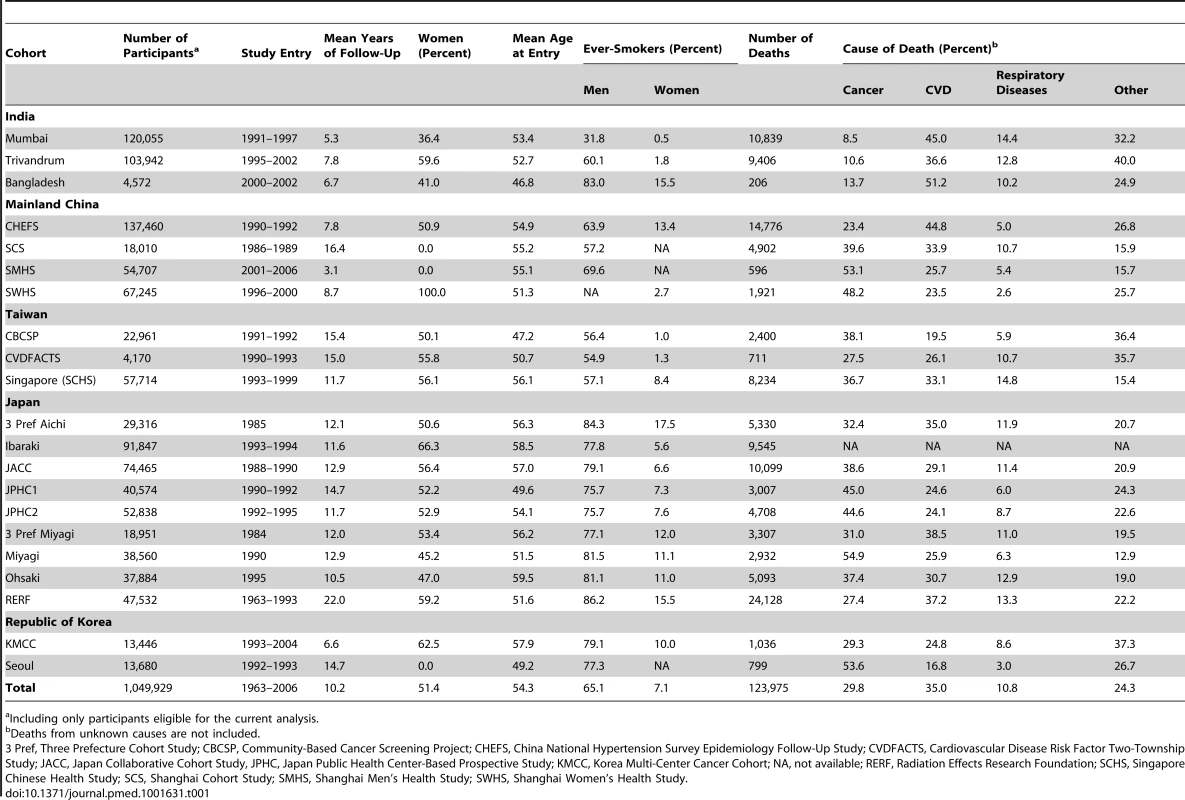
The number of deaths from a particular disease attributable to tobacco smoking was calculated by multiplying the PAR for that disease by the total number of deaths in the population from that disease. Analyses also were performed to estimate the number of deaths from a particular disease due to smoking for age groups 45–59, 60–69, and ≥70 y using age-specific HRs and smoking prevalence and then summing these age-specific estimates to obtain the overall number of deaths due to smoking for that disease. This age-specific method yielded similar results to the one without age-specific estimates, and, thus, the latter method was used, as it provides a tighter 95% CI than the age-specific method.
Results
A total of 1,223,092 participants were included in the 21 participating cohorts for this study. Because most studies were conducted among adults aged ≥45 y, participants (n = 70,812) who did not contribute person-years in the age group ≥45 y were excluded from this analysis. Also excluded (not mutually exclusively) were participants with prior history of cancer or CVD at baseline (n = 47,585), with missing data on tobacco smoking (n = 38,898) or vital status (n = 451), or with less than 1 y of observation after baseline survey (n = 30,039). After these exclusions, 1,049,929 participants (510,261 men; 539,668 women) remained (Table 1). Overall, the mean prevalence of tobacco smoking was 65.1% for men and 7.1% for women. Over a mean follow-up of 10.2 y through roughly the mid-2000s for most cohorts, a total of 123,975 deaths were identified in these cohorts.
Compared with never-smokers, a 1.44-fold higher risk (95% CI = 1.37–1.51) of deaths from all causes was observed among male ever-smokers in pooled analyses of all cohorts (Table 2). The estimated HRs related to smoking were slightly higher in Singapore, Republic of Korea, Japan, and Taiwan than in India and mainland China, although 95% CIs overlapped in some of these point estimates (heterogeneity test: p<0.001, I2 = 89 [95% CI = 85–92]). Among women, ever smoking was associated with a 1.48-fold higher risk (95% CI = 1.38–1.58) of death from any cause. This risk also varied across study populations (heterogeneity test: p<0.001, I2 = 82 [95% CI = 74–88]). The lowest elevation of risk was observed among Indian women, in which ever smoking was related to a 1.16-fold (95% CI = 0.98–1.36) elevated risk of deaths from all causes. Elevated risk of death was also seen among former smokers, although the risk was lower than among current smokers (Table S1).
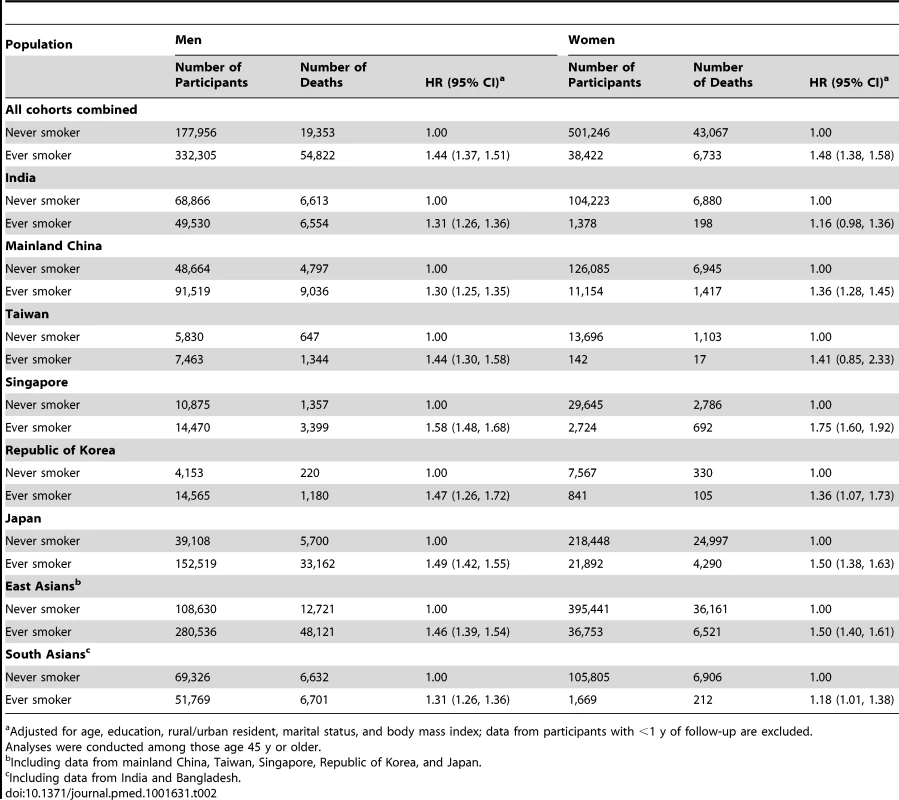
Among men, elevated risk of death due to CVD, cancer, and respiratory diseases was statistically significantly associated with ever smoking in virtually all study populations (Table 3). Ever smoking was associated with a 1.35-fold elevated risk (95% CI = 1.26–1.45) of death due to CVD in the analysis that included all cohorts. The risk, however, varied considerably across populations, with the strongest association observed in Taiwan (HR = 1.69; 95% CI = 1.36–2.10) and the weakest association observed in mainland China (HR = 1.17; 95% CI = 1.11–1.25) (heterogeneity test: p<0.001, I2 = 77 [95% CI = 66–85]). A 1.75-fold elevated risk (95% CI = 1.67–1.85) of death due to cancer in men was associated with ever smoking in the combined analysis of all cohorts. The association with cancer risk was, in general, quite consistent across study populations (heterogeneity test: p = 0.76). For death due to respiratory diseases in men, a 1.53-fold elevated risk (95% CI = 1.39–1.69) was associated with ever smoking in the combined analysis of all cohorts, and no statistically significant heterogeneity was identified (p = 0.29). Among East Asian women, positive associations were also observed between ever smoking and risk of major cause-specific deaths, with HRs ranging from 1.44 (95% CI = 1.23–1.69) for respiratory diseases to 1.59 for CVD (95% CI = 1.41–1.79) and cancer (95% CI = 1.45–1.75). Heterogeneity tests were statistically significant for cancer (p<0.001) and respiratory diseases (p = 0.003) but not for CVD (p = 0.20). Some of the country-specific risk estimates for East Asian women were not statistically significant because of low smoking prevalence among women in Asia. Among Indian women and all South Asian women combined, the association between ever smoking and risk of cause-specific deaths was weak and statistically nonsignificant.
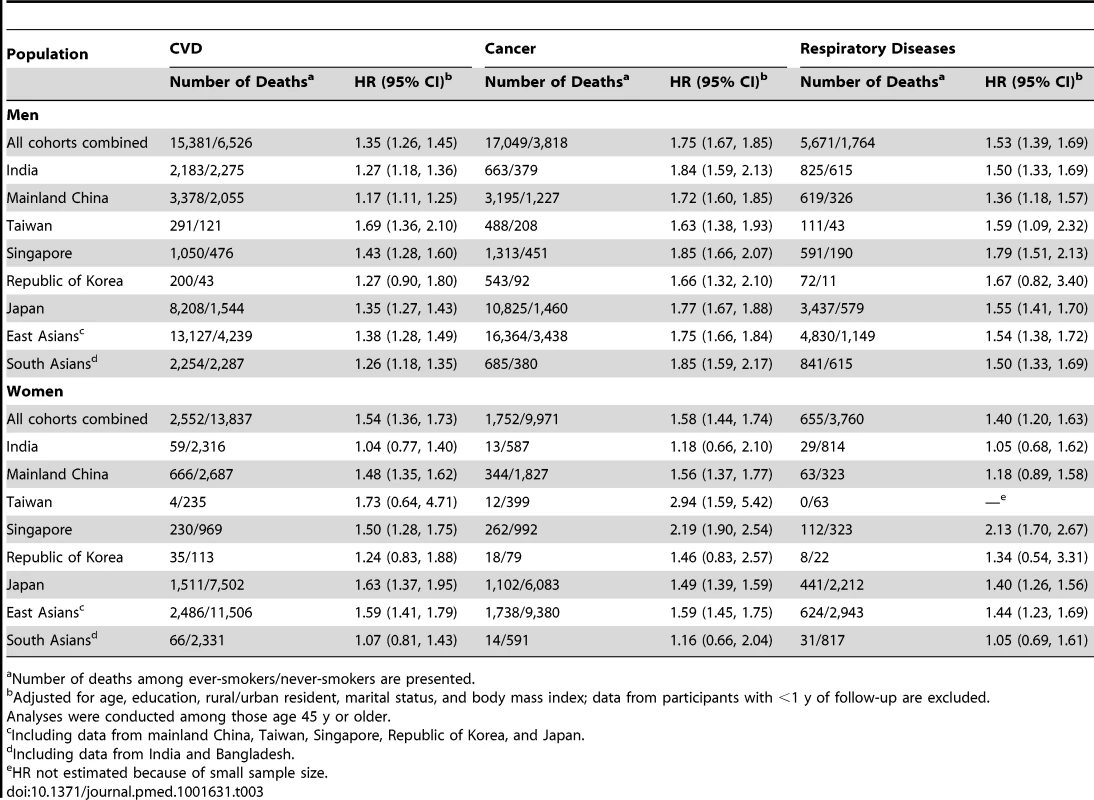
To quantify risk associated with smoking status and pack-years of smoking, we combined cohorts by ethnic background to improve the stability of point estimates. For men (Table 4) and women (Table 5), risk of total mortality and cause-specific mortality was elevated with increased tobacco smoking among current smokers, measured by pack-years of smoking. Excess deaths were also observed among former smokers, compared with never-smokers, although the risk was lower than for current smokers for deaths due to any cause, CVD, and cancer. A substantially elevated risk of death from respiratory diseases was found among former smokers, particularly in Chinese/Koreans and Indians/Bangladeshis. This excess is probably caused by some smokers quitting smoking after they developed respiratory diseases. Risks associated with smoking status and pack-years of smoking were not estimated for South Asian women because of the small sample size.
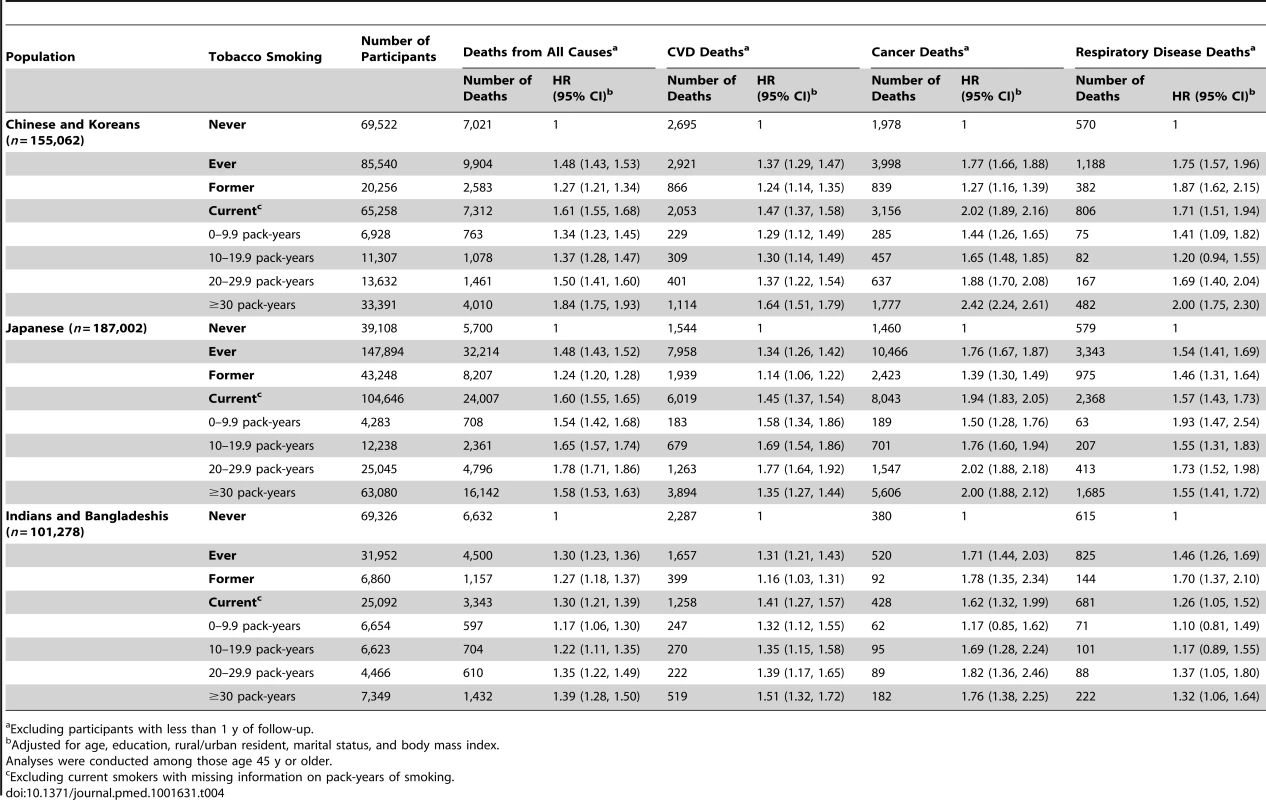
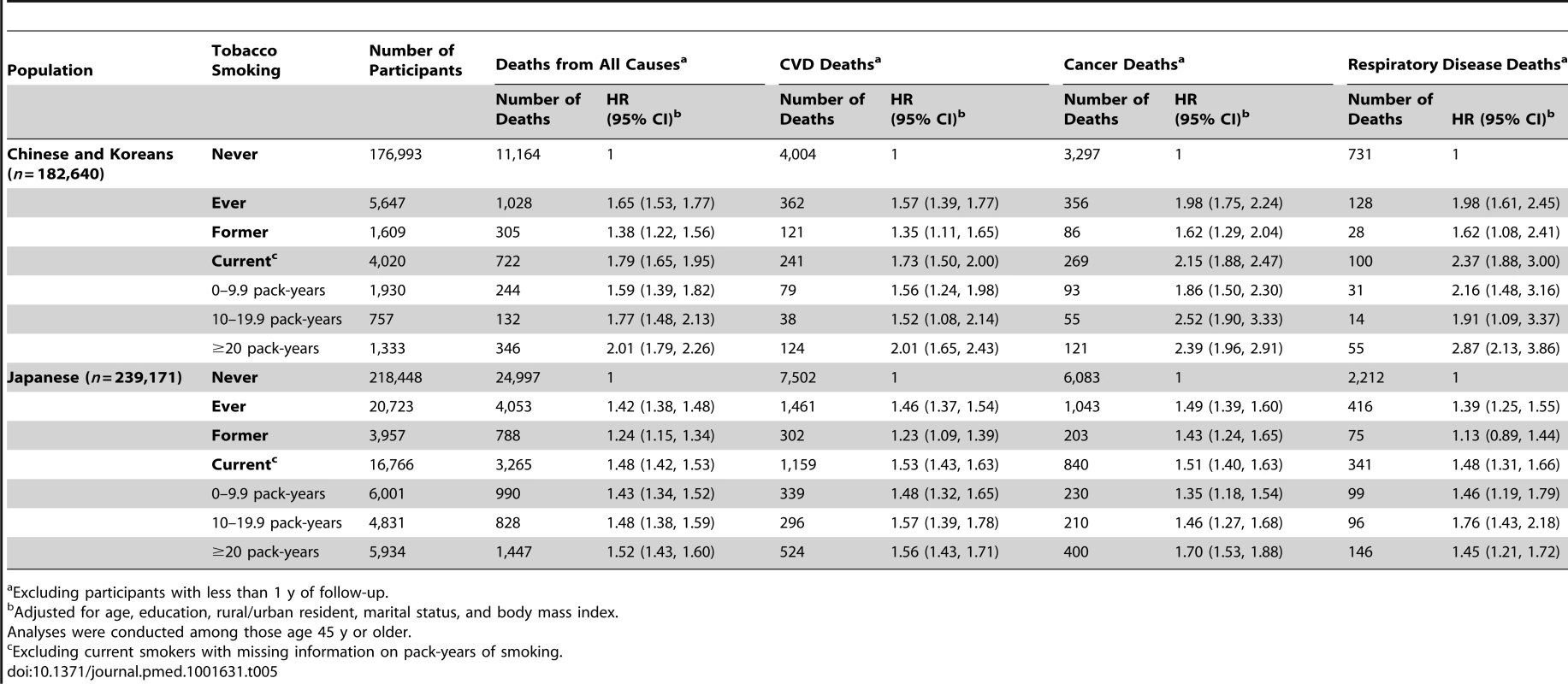
Further analyses were performed to estimate smoking-associated HRs for selected cancers as well as for other common diseases (Table 6). Among men and women, the strongest association with tobacco smoking was lung-cancer mortality: a 3- to 4-fold elevated risk consistently across all populations. In East Asian men, ever smoking was also associated with elevated risk for cancers of the mouth/pharynx/larynx, esophagus, stomach, colorectum, liver, pancreas, and bladder, cancers that have been consistently related to smoking in previous studies. HR estimates for South Asians were statistically nonsignificant or unreliable for several cancers, probably because of small sample sizes. Because of the relatively small sample size of female ever-smokers in South Asia, results are presented for East Asian women only. As in men, risks were elevated for virtually all smoking-related cancers.
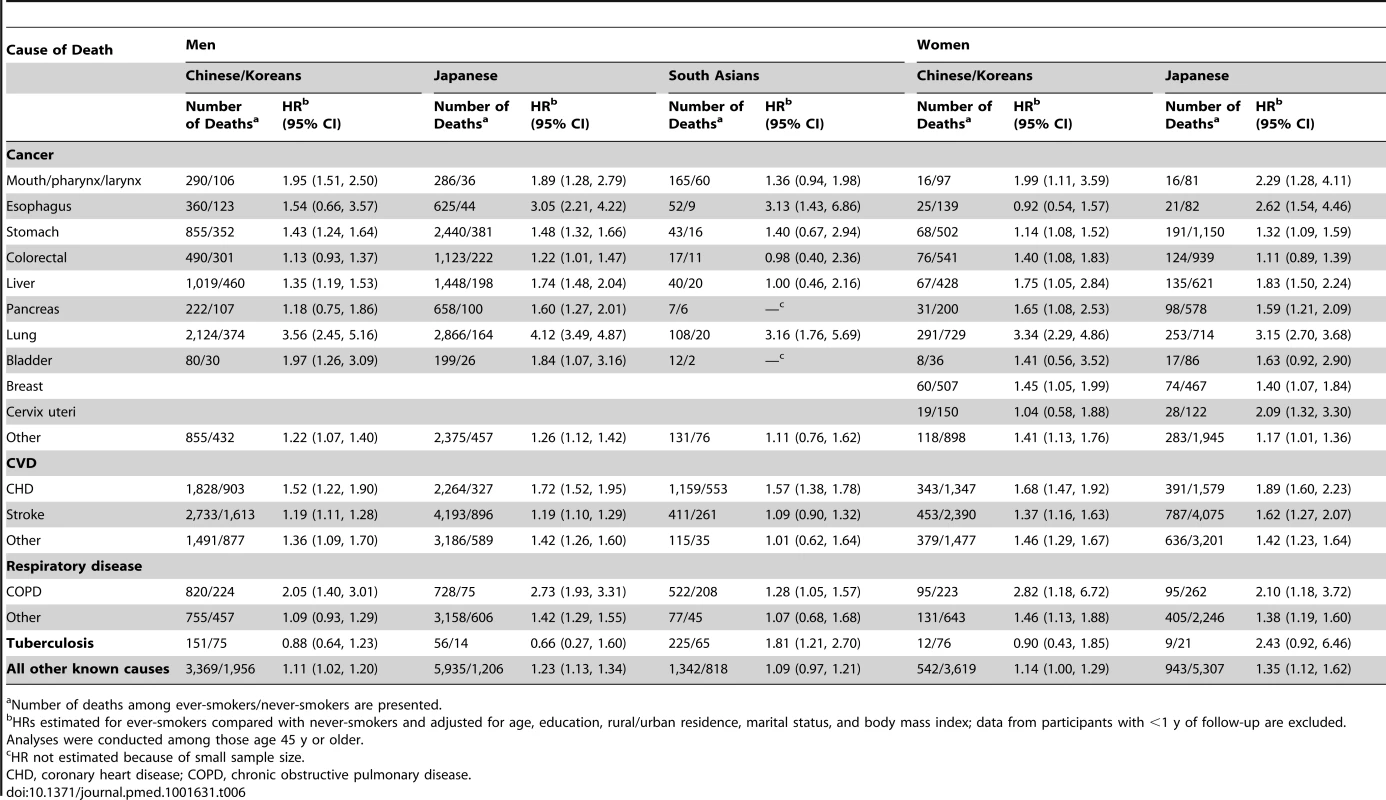
Among East Asian men and women, risks of death associated with smoking were elevated for coronary heart disease, stroke, and chronic obstructive pulmonary disease. Among South Asian men, the association was statistically significant for coronary heart disease and chronic obstructive pulmonary disease but not for stroke. Smoking was associated with elevated risk of death due to tuberculosis in South Asians. However, no association between smoking and tuberculosis was found in East Asians.
Among men ≥45 y, approximately 15.8% (95% CI = 14.3%–17.2%) of deaths (1.34 million [95% CI = 1.21–1.46 million]) from all causes in 2004 were attributable to tobacco smoking in these seven countries/regions combined (Table 7). Smoking-associated PARs for all-cause mortality were higher in Japan (27.7%), Republic of Korea (26.9%), and Singapore (24.8%) than in mainland China (16.2%), India (11.5%), Taiwan (19.7%), and Bangladesh (14.3%). Among women ≥45 y, tobacco smoking accounted for ∼3.3% (95% CI = 2.6%–4.0%) of total deaths (239,000 [95% CI = 188,300–289,700]) in the seven countries/regions combined in 2004.
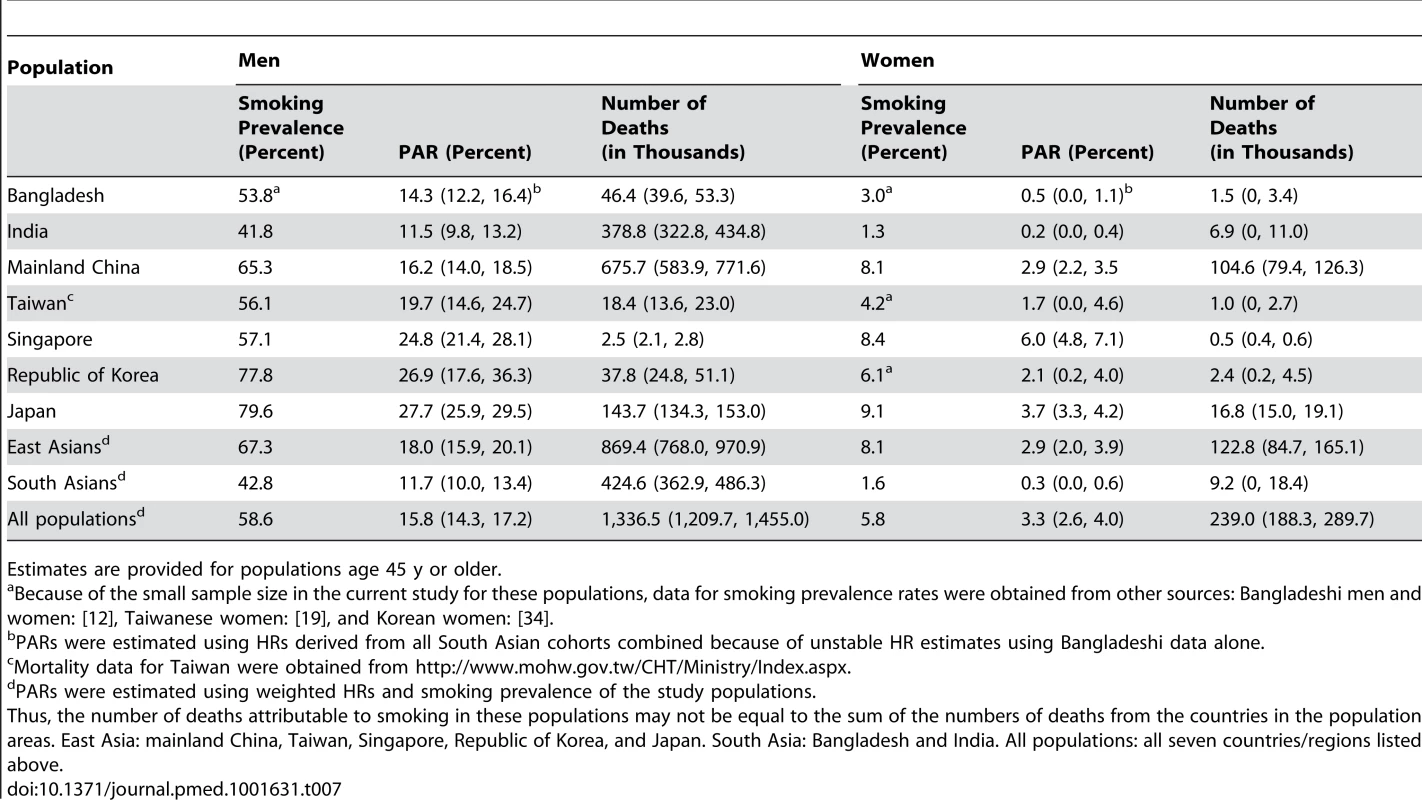
Among men aged ≥45 y, ∼11.4% (95% CI = 9.1%–13.8%), 30.5% (95% CI = 27.4%–33.6%), and 19.8% (95% CI = 14.8%–24.8%) of deaths due to CVD, cancer, and respiratory diseases, respectively, were attributable to tobacco smoking in 2004 (Table 8). Smoking-associated PARs for cause-specific mortality were also higher, in general, in Japan, Republic of Korea, and Singapore than in the other study populations. Overall, 60.5% (95% CI = 54.5%–66.4%) of lung cancer deaths in men were attributable to tobacco smoking. Data for women are presented for mainland China, Japan, and all East Asians combined, because of the small sample size for other groups. Smoking-associated PARs were much smaller in women than in men: 1.7% (95% CI = 0%–4.0%), 3.7% (95% CI = 2.4%–5.0%), and 4.6% (95% CI = 3.3%–5.8%) for deaths due to respiratory diseases, CVD, and cancer, respectively. Nevertheless, ∼16.7% (95% CI = 13.3%–20.0%) of lung-cancer deaths in East Asian women ≥45 y were attributable to tobacco smoking in 2004.
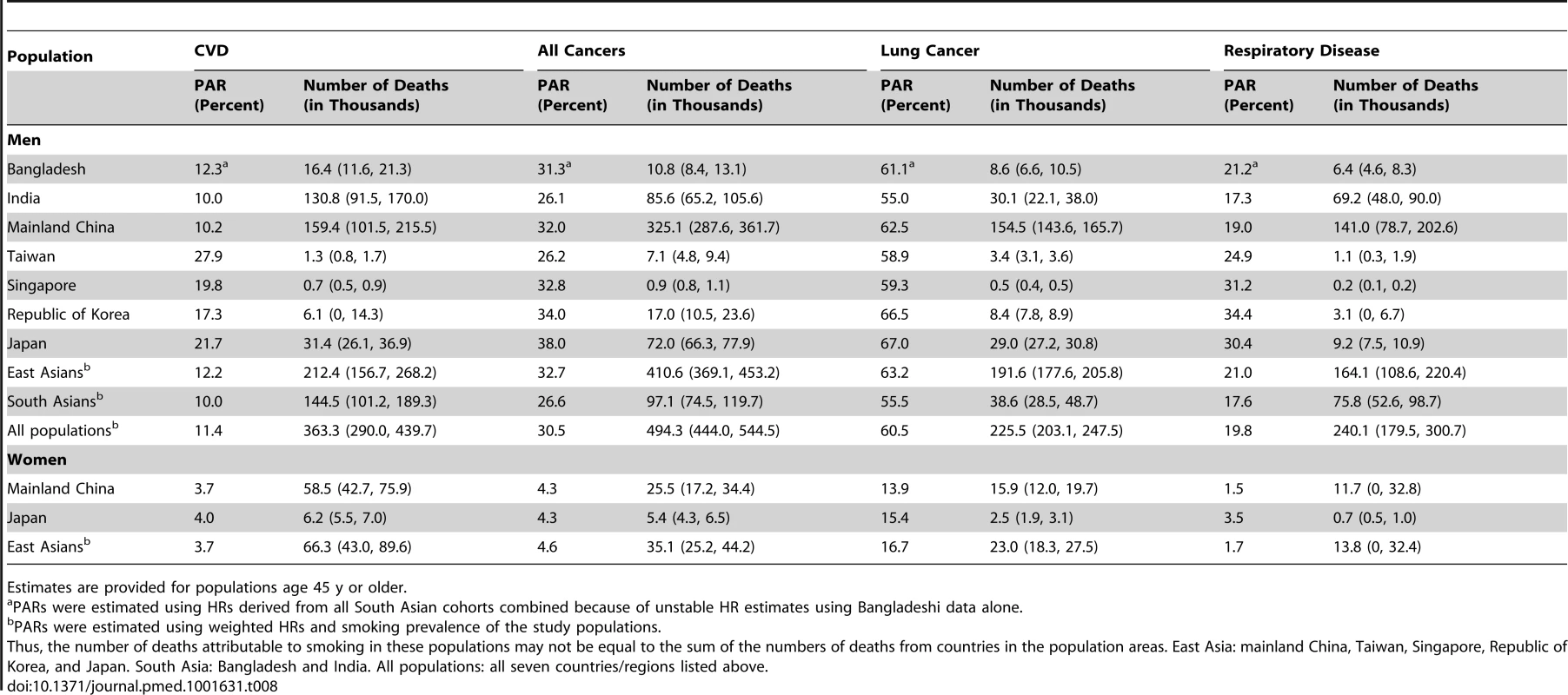
Discussion
Similar to studies conducted in Europe and North America [1]–[5],[9],[10], we found that tobacco smoking is associated with substantially elevated risk of total and cause-specific mortality. This study analyzed individual-level data from seven Asian countries/regions, using a uniform analytic approach, which enabled comparisons of smoking-associated HRs and PARs across these countries/regions. This study provides strong evidence that tobacco smoking is a major cause of death in Asia and underscores the importance and urgency of implementing comprehensive tobacco control programs for disease prevention in this populous continent.
Most smoking-associated RR estimates in this study were 1.3–1.5 for all-cause mortality, comparable to most estimates from previous studies conducted in Asia [14]–[21]. These RRs, however, are substantially lower than those from studies conducted in Europe and North America, where >2-fold elevated risk for all-cause mortality is typically reported for current smokers [1]–[3],[5],[9],[10]. Among specific causes of mortality evaluated in this study, lung cancer showed the strongest association with tobacco smoking, with estimated HRs of 3.0 to 4.0, approximately one-third of the risk observed in most studies conducted in Western countries [1]–[3],[5],[9],[10]. The smaller effect of smoking on mortality in Asia compared with Western countries could be partly explained by the fact that widespread tobacco smoking in most Asian countries began several decades later than in Europe and North America, and thus many Asian countries are still in the early stages of a tobacco epidemic; many smokers in the population started smoking tobacco at a late age and smoke a small number of cigarettes daily [3],[12]. In the British Doctors Study, a 1.6-fold elevated risk of all-cause mortality was observed among smokers in early years of follow-up (1951–1971) [26], close to the effect size estimated in this study. In later follow-up (1971–1991), the RR rose to 2.1. A recent Japanese study showed a clear birth-cohort effect: male smokers born before 1890 started smoking at a later age and smoked fewer cigarettes daily than those born in 1940–1945 [27]. As a result, the association of smoking with risk of all-cause mortality was weaker in the older cohort (RR = 1.24) than the younger cohort (RR = 1.92). Our study showed a clear dose–response relationship between pack-years of smoking and risk of all-cause and cause-specific mortality. It is likely that, with maturation of the tobacco epidemic in Asia and lack of effective tobacco control, more smokers will accumulate much higher pack-years of smoking, and, thus, smoking-associated RRs will rise, mirroring the trend in the US and Europe.
Several previous studies have estimated the burden of disease due to tobacco smoking in a specific Asian country/region [14],[16],[17],[19],[20] (Table S2). However, most previous estimates for smoking-associated RRs and PARs were derived from either a single cohort study [14],[19] or a retrospective case–control study [16]–[18]. Not all previous studies had detailed demographic and risk-factor information to adequately adjust for potential confounders when estimating risks. Three previous studies conducted in mainland China and Taiwan provided somewhat lower estimates of total male deaths due to smoking than our estimates, perhaps because these studies were conducted during even earlier stages of the tobacco epidemic in these populations, resulting in smaller PARs [14],[16],[19]. For India, however, the estimate of male deaths attributable to tobacco smoking from a previous study (20% of total male deaths) [17] was substantially higher than the estimate from our study (11.5% of total male deaths). To our knowledge, no study has been previously conducted in Bangladesh, the Republic of Korea, or Singapore; thus, our study provides, for the first time, direct estimates of deaths due to tobacco smoking in these countries. Despite methodological differences between this and previous studies, all studies conducted to date have shown that an alarming proportion of deaths are caused by tobacco smoking.
In this study, some estimates among women are unstable because of very low smoking prevalence. Although not all participating cohorts are representative of the general population, smoking-associated RRs estimated in this study, are, in general, comparable to those from previous studies. Furthermore, smoking-associated RRs estimated in multiple cohorts within the same country are, in general, comparable. It is difficult to find national survey data consistent with the definitions, time period, and age groups of our study for all seven countries/regions in our analysis. Many national surveys used a smaller sample than our study, providing unstable smoking prevalence estimates. Therefore, we chose to use smoking prevalence estimates from our own study to estimate PARs: smoking-associated RRs were estimated based on exposure history of the same group of individuals, which should provide better estimates of disease burden due to tobacco smoking in the study population than using data from external sources. Smoking prevalence has declined recently in several high-income Asian countries. However, given the long latency of chronic diseases, typically 15 y and longer, it is reasonable to use smoking prevalence rates assessed in the 1990s to estimate number of deaths due to tobacco smoking in 2004. As most of the cohort studies included in this study were conducted among adults aged ≥45 y, we were unable to estimate the impact of active tobacco smoking in people younger than 45 y old. Again, because of the long latency of chronic diseases, most of the smoking-related diseases tend to occur later in life.
We estimated smoking-associated PARs and numbers of deaths due to tobacco smoking in 2004. As many Asian countries, such as China and India, are still in the early stage of tobacco epidemics, the number of deaths due to tobacco smoking in more recent years in these countries is likely to be larger than that estimated in this study.
Data on secondhand tobacco-smoke exposure was not available in this study. Secondhand smoke has been linked to an elevated risk of multiple chronic diseases [2],[28],[29]. It has been estimated that approximately 603,000 deaths worldwide may be due to secondhand smoke [29]. We also were unable to evaluate smokeless tobacco, a risk factor for oral cancer and several other chronic diseases [30],[31]. Smokeless tobacco use is common in India and Bangladesh, especially among women in these countries. Some individuals who had secondhand tobacco-smoke exposure or used smokeless tobacco may be included in the reference group, which may result in an underestimate of the risk associated with active tobacco smoking. Furthermore, in our study, RRs associated with tobacco smoking were estimated primarily based on the time period from the early 1990s to the mid-2000s. Because smoking-associated risk of death is likely to increase with the maturation of the tobacco epidemic, the total number of deaths due to smoking in 2004 may be underestimated using this set of RRs. Therefore, the true impact of tobacco smoking on mortality in these Asian countries is likely to be even larger than estimated here. Despite some limitations mentioned above, our study provides perhaps the best estimates of tobacco-associated deaths to date in these Asian countries/regions.
Over the past 50 years, the landscape of tobacco smoking has changed dramatically around the world. Smoking prevalence has declined sharply in many high-income countries, resulting in a recent decrease in smoking-related deaths, particularly among men [3],[8]. Conversely, prevalence of tobacco use remains high in China, India, and other low- and middle-income countries. As the tobacco epidemic grows in these countries, we anticipate that an increasing number of deaths will be attributable to tobacco smoking in Asia in the coming years. Even in more well-developed Asian countries such as Japan and Republic of Korea, where smoking rates have recently declined, the full impact of tobacco smoking on mortality is unlikely to be seen soon because, as noted above, smokers in recent birth cohorts tend to smoke more and start smoking earlier, elevating their risk of smoking-associated deaths, and because of the long latency of the diseases associated with smoking, these deaths will not accrue immediately. Our study shows that tobacco smoking is a major cause of death in Asia, accounting for ∼1.6 million deaths of adults ≥45 y in 2004 in the seven countries/regions in this analysis. If the remaining 29% of the Asian population is experiencing a tobacco epidemic similar to that of these seven countries/regions, we estimate that, in 2004, >2 million deaths in Asia were attributable to tobacco smoking. Thus, of the 5 million deaths currently attributable to active tobacco smoking worldwide [32], nearly 45% occur in Asia. Our study provides sobering evidence that stresses the urgency of implementing comprehensive tobacco control programs in Asia, as recommended by the WHO Framework Convention on Tobacco Control [33]. Tobacco control should be among the top priorities in Asia to reduce the burden of disease.
Supporting Information
Zdroje
1. US Department of Health and Human Services (1989) Reducing the health consequences of smoking: 25 years of progress. A report of the Surgeon General. DHHS Publication No. CDC 89–8411. Rockville (Maryland): US Department of Health and Human Services.
2. IARC Working Group on the Evaluation of Carcinogenic Risks to Humans (2004) Tobacco smoke and involuntary smoking. IARC Monogr Eval Carcinog Risks Hum 8: 1–1438.
3. JhaP (2009) Avoidable global cancer deaths and total deaths from smoking. Nat Rev Cancer 9: 655–664.
4. Forey B, Hamling J, Lee P, Wald N, editors (2009) International smoking statistics: a collection of historical data from 30 economically developed countries. New York: Oxford University Press.
5. PirieK, PetoR, ReevesGK, GreenJ, BeralV, et al. (2013) The 21st century hazards of smoking and benefits of stopping: a prospective study of one million women in the UK. Lancet 381: 133–141.
6. PetoR, LopezAD, BorehamJ, ThunM, HeathCJr (1992) Mortality from tobacco in developed countries: indirect estimation from national vital statistics. Lancet 339: 1268–1278.
7. EzzatiM, LopezAD (2003) Estimates of global mortality attributable to smoking in 2000. Lancet 362: 847–852.
8. Peto R, Lopez AD, Boreham J, Thun M (2012) Mortality from smoking in developed countries, 1950–2005 (or later). Oxford: University of Oxford Clinical Trial Service Unit. Available: http://www.ctsu.ox.ac.uk/~tobacco/. Accessed 18 Mar 2014.
9. ThunMJ, CarterBD, FeskanichD, FreedmanND, PrenticeR, et al. (2013) 50-year trends in smoking-related mortality in the United States. N Engl J Med 368: 351–364.
10. JhaP, RamasundarahettigeC, LandsmanV, RostronB, ThunM, et al. (2013) 21st-century hazards of smoking and benefits of cessation in the United States. N Engl J Med 368: 341–350.
11. MolariusA, ParsonsRW, DobsonAJ, EvansA, FortmannSP, et al. (2001) WHO MONICA Project. Trends in cigarette smoking in 36 populations from the early 1980s to the mid-1990s: findings from the WHO MONICA Project. Am J Public Health 91: 206–212.
12. GiovinoGA, MirzaSA, SametJM, GuptaPC, JarvisMJ, et al. (2012) Tobacco use in 3 billion individuals from 16 countries: an analysis of nationally representative cross-sectional household surveys. Lancet 380: 668–679.
13. Chan M (2008) WHO report on the global tobacco epidemic 2008. Geneva: World Health Organization.
14. GuD, KellyTN, WuX, ChenJ, SametJM, et al. (2009) Mortality attributable to smoking in China. N Engl J Med 360: 150–159.
15. ChenZM, XuZ, CollinsR, LiWX, PetoR (2007) Early health effects of the emerging tobacco epidemic in China. A 16-year prospective study. JAMA 278: 1500–1504.
16. LiuBQ, PetoR, ChenZM, BorehamJ, WuYP, et al. (1998) Emerging tobacco hazards in China: 1. retrospective proportional mortality study of one million deaths. BMJ 317: 1411–1422.
17. JhaP, JacobB, GajalakshmiV, GuptaPC, DhingraN, et al. (2008) A nationally representative case-control study of smoking and death in India. N Engl J Med 58: 1137–1147.
18. LamTH, HoSY, HedleyAJ, MakKH, PetoR (2001) Mortality and smoking in Hong Kong: case-control study of all adult deaths in 1998. BMJ 323: 361.
19. LiawKM, ChenCJ (1998) Mortality attributable to cigarette smoking in Taiwan: a 12-year follow-up study. Tob Control 7: 141–148.
20. KatanodaK, MarugameT, SaikaK, SatohH, TajimaK, et al. (2008) Population attributable fraction of mortality associated with tobacco smoking in Japan: a pooled analysis of three large-scale cohort studies. J Epidemiol 18: 251–264.
21. MurakamiY, MiuraK, OkamuraT, UeshimaH (2011) EPOCH-JAPAN Research Group (2011) Population attributable numbers and fractions of deaths due to smoking: a pooled analysis of 180,000 Japanese. Prev Med 52: 60–65.
22. Mathers C, Boerma JT, Fat DM, World Health Organization (2008) The global burden of disease: 2004 update. Geneva: World Health Organization.
23. ZhengW, McLerranDF, RollandB, ZhangX, InoueM, et al. (2011) Association between body-mass index and risk of death in more than 1 million Asians. N Engl J Med 364: 719–729.
24. BrockwellSE, GordonIR (2001) A comparison of statistical methods for meta-analysis. Stat Med 20: 825–840.
25. DerSimonianR, LairdN (1986) Meta-analysis in clinical trials. Control Clin Trials 7: 177–188.
26. DollR, PetoR, WheatleyK, GrayR, SutherlandI (1994) Mortality in relation to smoking: 40 years' observations on male British doctors. BMJ 309: 901–911.
27. SakataR, McGaleP, GrantEJ, OzasaK, PetoR, et al. (2012) Impact of smoking on mortality and life expectancy in Japanese smokers: a prospective cohort study. BMJ 345: e7093.
28. WhincupPH, GilgJA, EmbersonJR, JarvisMJ, FeyerabendC, et al. (2004) Passive smoking and risk of coronary heart disease and stroke: prospective study with cotinine measurement. BMJ 329: 200–205.
29. ObergM, JaakkolaMS, WoodwardA, PerugaA, Prüss-UstünA (2011) Worldwide burden of disease from exposure to second-hand smoke: a retrospective analysis of data from 192 countries. Lancet 377: 139–146.
30. IARC Working Group on the Evaluation of Carcinogenic Risks to Humans (2007) Smokeless tobacco and some tobacco-specific N-nitrosamines. IARC Monogr Eval Carcinog Risks Hum 89: 1–592.
31. Thun MJ, Heenley SJ (2006) Tobacco. In: Schottenfeld F, Fraumeni JF Jr, editors. Cancer epidemiology and prevention. New York: Oxford University Press. pp. 217–242.
32. MathersCD, LoncarD (2006) Projections of global mortality and burden of disease from 2002 to 2030. PLoS Med 3: e442.
33. World Health Organization (2003) WHO Framework Convention on Tobacco Control. Geneva: World Health Organization.
34. JeeSH, SullJW, ParkJ, LeeSY, OhrrH, et al. (2006) Body-mass index and mortality in Korean men and women. N Engl J Med 355: 779–787.
Štítky
Interné lekárstvoČlánok vyšiel v časopise
PLOS Medicine
2014 Číslo 4
- Parazitičtí červi v terapii Crohnovy choroby a dalších zánětlivých autoimunitních onemocnění
- Statiny indukovaná myopatie: Jak na diferenciální diagnostiku?
- Metabolit živočišné stravy produkovaný střevní mikroflórou zvyšuje riziko závažných kardiovaskulárních příhod
- Zástava srdce u pacienta se střelnými ranami – kazuistika
- DESATORO PRE PRAX: Aktuálne odporúčanie ESPEN pre nutričný manažment u pacientov s COVID-19
Najčítanejšie v tomto čísle
- Burden of Total and Cause-Specific Mortality Related to Tobacco Smoking among Adults Aged ≥45 Years in Asia: A Pooled Analysis of 21 Cohorts
- What We Know and What We Don't Know About Preventing Stroke
- Safety of Pediatric HIV Elimination: The Growing Population of HIV- and Antiretroviral-Exposed but Uninfected Infants
- Regional Changes in Charcoal-Burning Suicide Rates in East/Southeast Asia from 1995 to 2011: A Time Trend Analysis
